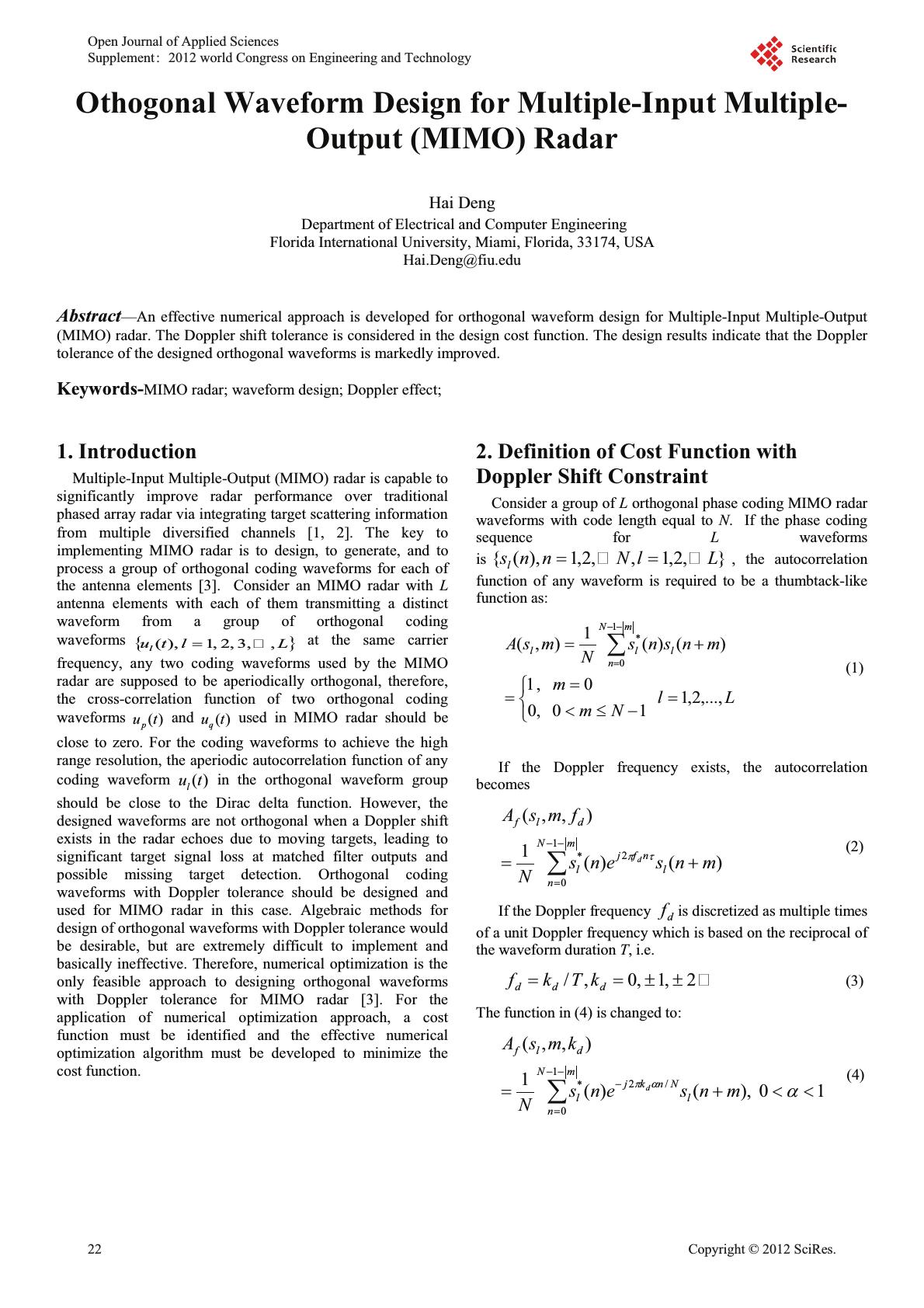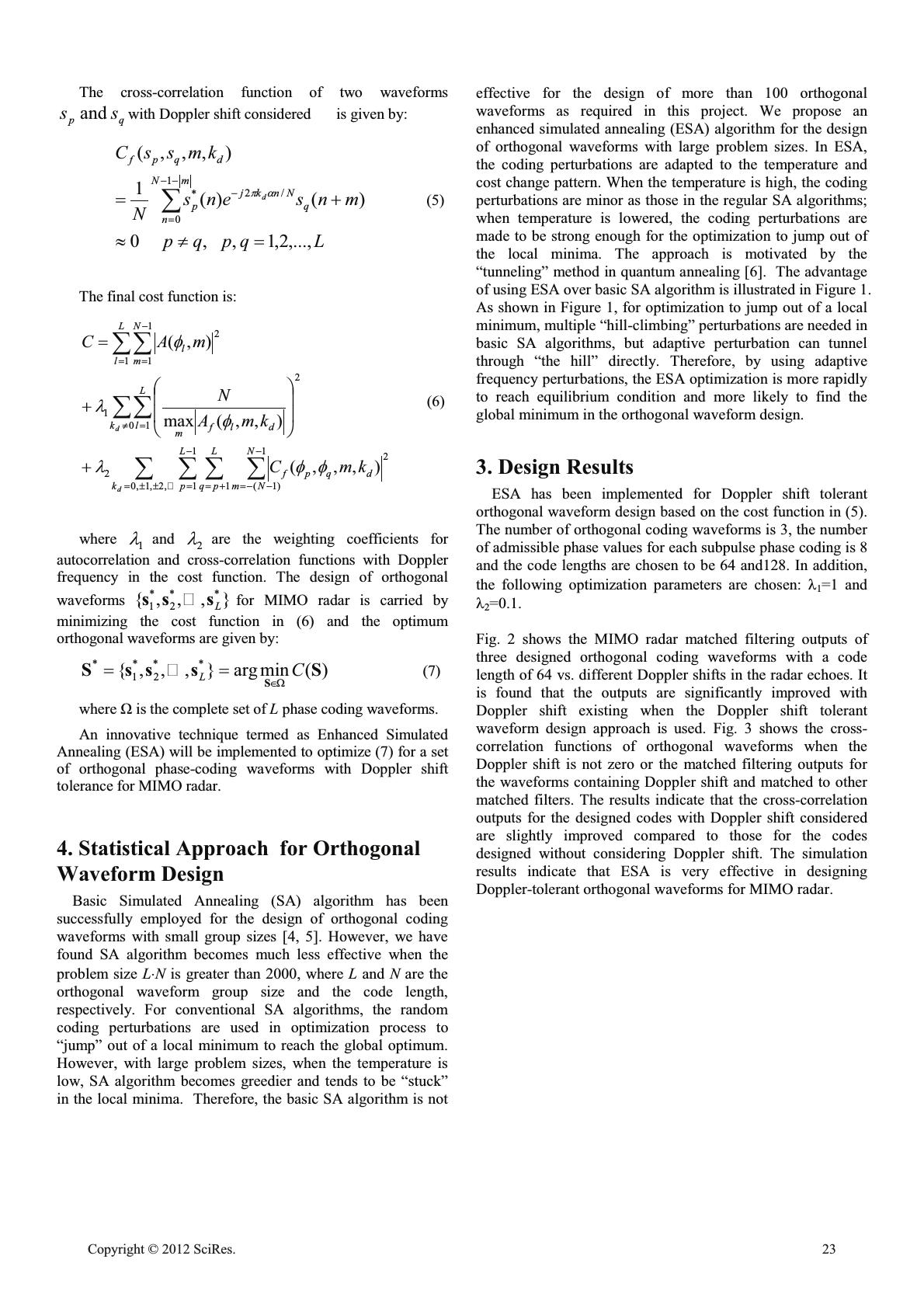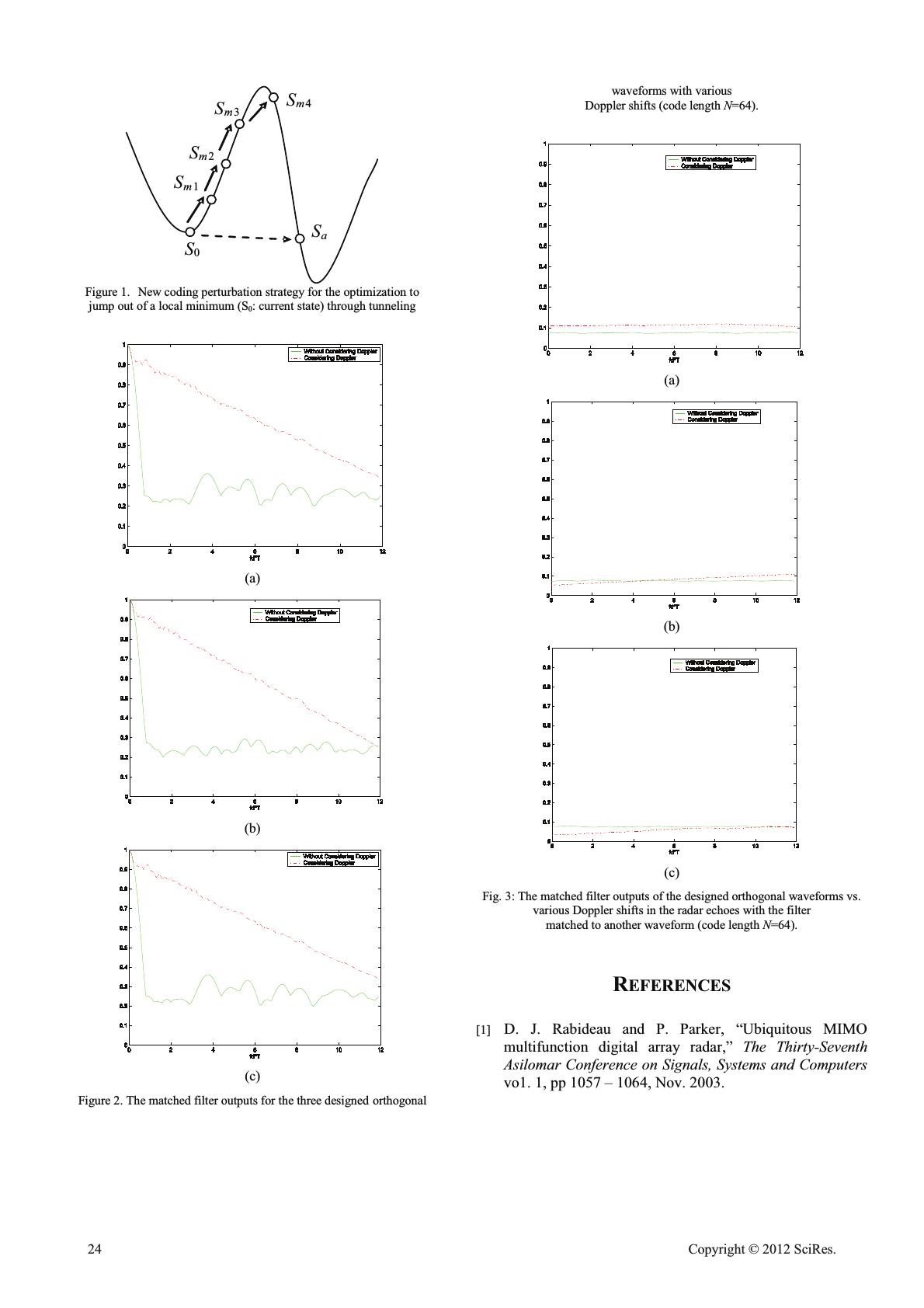Paper Menu >>
Journal Menu >>
 Othogonal Waveform Design for Multiple-Input Multiple- Output (MIMO) Radar Hai Deng Department of Electrical and Computer Engineering Florida International University, Miami, Florida, 33174, USA Hai.Deng@fiu.edu Abstract—An effective numerical approach is developed for orthogonal waveform design for Multiple-Input Multiple-Output (MIMO) radar. The Doppler shift tolerance is considered in the design cost function. The design results indicate that the Doppler tolerance of the designed orthogonal waveforms is markedly improved. Keywords-MIMO radar; waveform design; Doppler effect; 1. Introduction Multiple-Input Multiple-Output (MIMO) radar is capable to significantly improve radar performance over traditional phased array radar via integrating target scattering information from multiple diversified channels [1, 2]. The key to implementing MIMO radar is to design, to generate, and to process a group of orthogonal coding waveforms for each of the antenna elements [3]. Consider an MIMO radar with L antenna elements with each of them transmitting a distinct waveform from a group of orthogonal coding waveforms ^` Lltu l ,3, ,2 ,1 ),( at the same carrier frequency, any two coding waveforms used by the MIMO radar are supposed to be aperiodically orthogonal, therefore, the cross-correlation function of two orthogonal coding waveforms )(tu p and )(tu q used in MIMO radar should be close to zero. For the coding waveforms to achieve the high range resolution, the aperiodic autocorrelation function of any coding waveform )(tul in the orthogonal waveform group should be close to the Dirac delta function. However, the designed waveforms are not orthogonal when a Doppler shift exists in the radar echoes due to moving targets, leading to significant target signal loss at matched filter outputs and possible missing target detection. Orthogonal coding waveforms with Doppler tolerance should be designed and used for MIMO radar in this case. Algebraic methods for design of orthogonal waveforms with Doppler tolerance would be desirable, but are extremely difficult to implement and basically ineffective. Therefore, numerical optimization is the only feasible approach to designing orthogonal waveforms with Doppler tolerance for MIMO radar [3]. For the application of numerical optimization approach, a cost function must be identified and the effective numerical optimization algorithm must be developed to minimize the cost function. 2. Definition of Cost Function with Doppler Shift Constraint Consider a group of L orthogonal phase coding MIMO radar waveforms with code length equal to N. If the phase coding sequence for L waveforms is },2,1,,2,1),({ LlNnnsl , the autocorrelation function of any waveform is required to be a thumbtack-like function as: Ll Nm m mnsns N msA mN n lll ,...,2,1 10 ,0 0 , 1 )()( 1 ),( 1 0 * ¯ ® d ¦ (1) If the Doppler frequency exists, the autocorrelation becomes ¦ mN n l nfj l dlf mnsens N fmsA d 1 0 2 * )()( 1 ),,( WS (2) If the Doppler frequency d fis discretized as multiple times of a unit Doppler frequency which is based on the reciprocal of the waveform duration T, i.e. 2 ,1 ,0,/rr ddd kTkf (3) The function in (4) is changed to: 10 ,)()( 1 ),,( 1 0 /2 * ¦ D DS mN n l Nnkj l dlf mnsens N kmsA d (4) Open Journal of Applied Sciences Supplement:2012 world Congress on Engineering and Technology 22 Cop y ri g ht © 2012 SciRes.  The cross-correlation function of two waveforms qp ss and with Doppler shift considered is given by: Lqpqp mnsens N kmssC mN n q Nnkj p dqpf d ,...,2,1 , , 0 )()( 1 ),,,( 1 0 /2 * z| ¦ DS (5) The final cost function is: ¦¦¦¦ ¦¦ ¦¦ rr z ¸ ¸ ¹ · ¨ ¨ © § ,2,1,0 1 11 1 )1( 2 2 01 2 1 1 1 1 2 ),,,( ),,(max ),( d d k L p L pq N Nm dqpf k L ldlf m L l N m l kmC kmA N mAC IIO I O I (6) where 1 O and 2 O are the weighting coefficients for autocorrelation and cross-correlation functions with Doppler frequency in the cost function. The design of orthogonal waveforms },,,{ ** 2 * 1L sss for MIMO radar is carried by minimizing the cost function in (6) and the optimum orthogonal waveforms are given by: )(minarg},,,{ ** 2 * 1 * SsssS S C L: (7) L phase coding waveforms. An innovative technique termed as Enhanced Simulated Annealing (ESA) will be implemented to optimize (7) for a set of orthogonal phase-coding waveforms with Doppler shift tolerance for MIMO radar. 4. Statistical Approach for Orthogonal Waveform Design Basic Simulated Annealing (SA) algorithm has been successfully employed for the design of orthogonal coding waveforms with small group sizes [4, 5]. However, we have found SA algorithm becomes much less effective when the problem size LN is greater than 2000, where L and N are the orthogonal waveform group size and the code length, respectively. For conventional SA algorithms, the random coding perturbations are used in optimization process to “jump” out of a local minimum to reach the global optimum. However, with large problem sizes, when the temperature is low, SA algorithm becomes greedier and tends to be “stuck” in the local minima. Therefore, the basic SA algorithm is not effective for the design of more than 100 orthogonal waveforms as required in this project. We propose an enhanced simulated annealing (ESA) algorithm for the design of orthogonal waveforms with large problem sizes. In ESA, the coding perturbations are adapted to the temperature and cost change pattern. When the temperature is high, the coding perturbations are minor as those in the regular SA algorithms; when temperature is lowered, the coding perturbations are made to be strong enough for the optimization to jump out of the local minima. The approach is motivated by the “tunneling” method in quantum annealing [6]. The advantage of using ESA over basic SA algorithm is illustrated in Figure 1. As shown in Figure 1, for optimization to jump out of a local minimum, multiple “hill-climbing” perturbations are needed in basic SA algorithms, but adaptive perturbation can tunnel through “the hill” directly. Therefore, by using adaptive frequency perturbations, the ESA optimization is more rapidly to reach equilibrium condition and more likely to find the global minimum in the orthogonal waveform design. 3. Design Results ESA has been implemented for Doppler shift tolerant orthogonal waveform design based on the cost function in (5). The number of orthogonal coding waveforms is 3, the number of admissible phase values for each subpulse phase coding is 8 and the code lengths are chosen to be 64 and128. In addition, the following optimization parameters are chosen: O1=1 and O2=0.1. Fig. 2 shows the MIMO radar matched filtering outputs of three designed orthogonal coding waveforms with a code length of 64 vs. different Doppler shifts in the radar echoes. It is found that the outputs are significantly improved with Doppler shift existing when the Doppler shift tolerant waveform design approach is used. Fig. 3 shows the cross- correlation functions of orthogonal waveforms when the Doppler shift is not zero or the matched filtering outputs for the waveforms containing Doppler shift and matched to other matched filters. The results indicate that the cross-correlation outputs for the designed codes with Doppler shift considered are slightly improved compared to those for the codes designed without considering Doppler shift. The simulation results indicate that ESA is very effective in designing Doppler-tolerant orthogonal waveforms for MIMO radar. Cop y ri g ht © 2012 SciRes.23  S 0 S m1 S a S m2 S m3 S m4 Figure 1. New coding perturbation strategy for the optimization to jump out of a local minimum (S0: current state) through tunneling (a) (b) (c) Figure 2. The matched filter outputs for the three designed orthogonal waveforms with various Doppler shifts (code length N=64). (a) (b) (c) Fig. 3: The matched filter outputs of the designed orthogonal waveforms vs. various Doppler shifts in the radar echoes with the filter matched to another waveform (code length N=64). REFERENCES [1] D. J. Rabideau and P. Parker, “Ubiquitous MIMO multifunction digital array radar,” The Thirty-Seventh Asilomar Conference on Signals, Systems and Computers vo1. 1, pp 1057 – 1064, Nov. 2003. 24 Cop y ri g ht © 2012 SciRes.  [2] F. C. Robey and et al, “MIMO radar theory and experimental results,” The Thirty-Eighth Asilomar Conference on Signals, Systems and Computers vo1. 1, pp 300 – 304, Nov. 2004. [3] H. Deng, “Polyphase coding signal design for orthogonal netted radar systems,” IEEE Transactions on Signal Processing, vol. 52, pp. 3126-3135, November 2004. [4] S. Kirkpatrick, C. D. Gelatt and M. P. Vecchi, “Optimization by simulated annealing,” Science, vol. 220, pp. 671-680, May 1983. [5] L. Ingber, Adaptive simulated annealing (ASA): Lessons learned, Control and Cybernetics, vol. 25, pp. 33-54, no.1, Jan. 1996. [6] Arnab Das and Bikas K. Chakrabarti (Eds.), Quantum Annealing and Related Optimization Methods, Lecture Note in Physics, vol. 679, Springer, Heidelberg, Germany, 2005. Cop y ri g ht © 2012 SciRes.25 |

